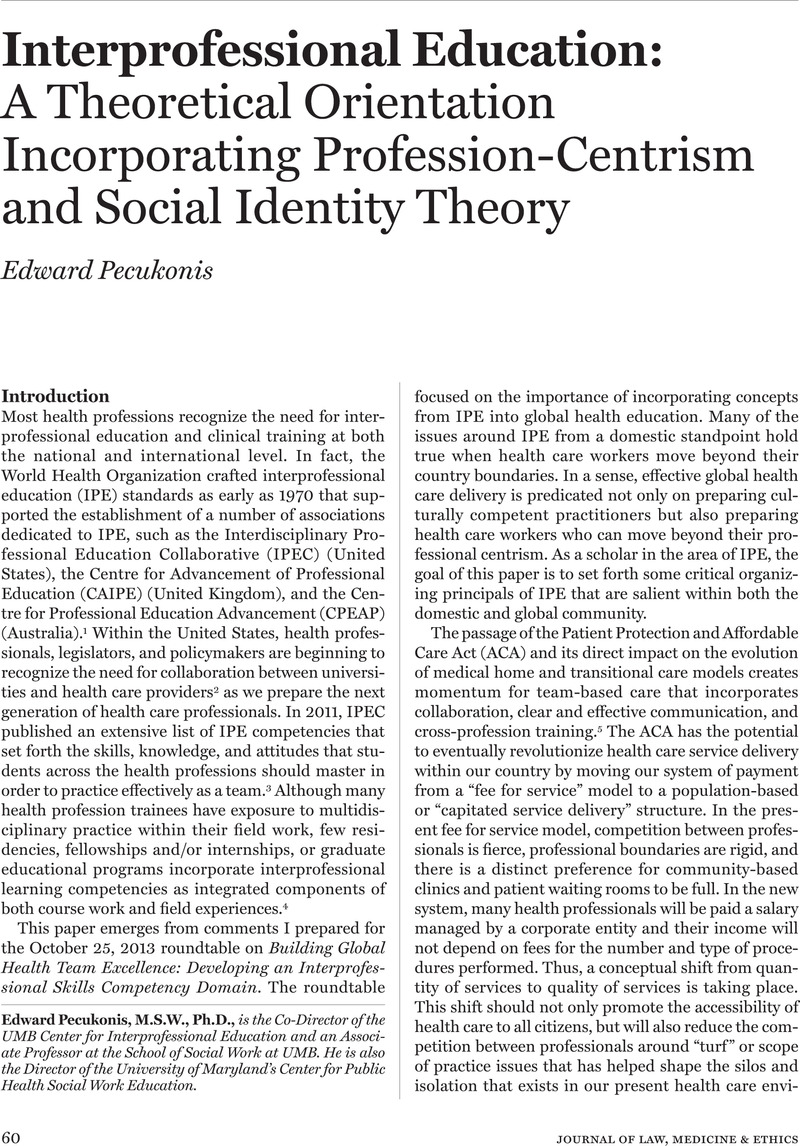Crossref Citations
This article has been cited by the following publications. This list is generated based on data provided by Crossref.
Rowthorn, Virginia
Olsen, Jody
and
Hirshon, Jon Mark
2014.
Introduction.
Journal of Law, Medicine & Ethics,
Vol. 42,
Issue. S2,
p.
5.
Komendziński, Tomasz
Dreszer-Drogorób, Joanna
Mikołajewska, Emilia
Mikołajewski, Dariusz
and
Bałaj, Bibianna
2016.
Organizational Culture and Ethics in Modern Medicine.
p.
78.
Hallam, Karen T.
Livesay, Karen
Morda, Romana
Sharples, Jenny
Jones, Andi
and
de Courten, Maximilian
2016.
Do commencing nursing and paramedicine students differ in interprofessional learning and practice attitudes: evaluating course, socio-demographic and individual personality effects.
BMC Medical Education,
Vol. 16,
Issue. 1,
Meleis, Afaf I.
2016.
Interprofessional Education: A Summary of Reports and Barriers to Recommendations.
Journal of Nursing Scholarship,
Vol. 48,
Issue. 1,
p.
106.
Tartavoulle, Todd M.
English, Robin
Gunaldo, Tina Patel
Garbee, Deborah
Mercante, Donald E.
Andrieu, Sandra Carlin
and
Johnson, Jessica L.
2016.
Using the IDEA framework in an interprofessional didactic elective course to facilitate positive changes in the roles and responsibility competency.
Journal of Interprofessional Education & Practice,
Vol. 2,
Issue. ,
p.
21.
Roth, Louise Marie
Henley, Megan M.
Seacrist, Marla J.
and
Morton, Christine H.
2016.
North American Nurses' and Doulas' Views of Each Other.
Journal of Obstetric, Gynecologic & Neonatal Nursing,
Vol. 45,
Issue. 6,
p.
790.
Will, Kristen Kaye
Stepanek, Jan
Brewer, Kathryn K.
Colquist, Julie A.
Cruz, Jade Ethel S.
Donald, Carrlene B.
Hartsell, Zachary C.
Hust, Steven J.
Lowell, Amelia A.
Markiewicz, Katherine A.
Panchmatia, Bella
Shelton, A. Travis
Novais, Barbara S.
and
Wilson, Rebecca
2016.
Interprofessional orientation for health professionals utilising simulated learning: Findings from a pilot study.
Journal of Interprofessional Care,
Vol. 30,
Issue. 2,
p.
254.
Morgan, C. Jane
2017.
Graduates’ development of interprofessional practice capability during their early socialisation into professional roles.
Journal of Interprofessional Care,
Vol. 31,
Issue. 4,
p.
438.
Borrott, Narelle
Kinney, Sharon
Newall, Fiona
Williams, Allison
Cranswick, Noel
Wong, Ian
and
Manias, Elizabeth
2017.
Medication communication between nurses and doctors for paediatric acute care: An ethnographic study.
Journal of Clinical Nursing,
Vol. 26,
Issue. 13-14,
p.
1978.
Komendziński, Tomasz
Dreszer-Drogorób, Joanna
Mikołajewska, Emilia
Mikołajewski, Dariusz
and
Bałaj, Bibianna
2017.
Medical Education and Ethics.
p.
203.
King, Martin
Chambers, Alison
Miller, Eula
Hook, Angela
Jackson, Laura
Gurbutt, Russell
and
Woods-Gallagher, Shirley
2018.
Reimagining Undergraduate Health and Social Care Education: A Workforce Fit for Purpose in a Changing Landscape of Care. A Position Paper.
Illness, Crisis & Loss,
Vol. 26,
Issue. 2,
p.
145.
Boland, Daubney
White, Traci
and
Adams, Eve
2018.
Experiences of Pharmacy Trainees from an Interprofessional Immersion Training.
Pharmacy,
Vol. 6,
Issue. 2,
p.
37.
Sollami, Alfonso
Caricati, Luca
and
Mancini, Tiziana
2018.
Attitudes towards Interprofessional Education among Medical and Nursing Students: the Role of Professional Identification and Intergroup Contact.
Current Psychology,
Vol. 37,
Issue. 4,
p.
905.
Mouser, April L
Wallace, Linda
Whitmore, Bridget
and
Sebastian, Heidi
2018.
Bridging understanding in nursing and radiography students: An interprofessional experience.
Nursing Forum,
Vol. 53,
Issue. 2,
p.
129.
Gorantla, Suhas
Bansal, Utkarsh
Singh, Jai Vir
Dwivedi, Akhilesh Dutta
Malhotra, Atul
and
Kumar, Arunaz
2019.
Introduction of an undergraduate interprofessional simulation based skills training program in obstetrics and gynaecology in India.
Advances in Simulation,
Vol. 4,
Issue. 1,
Lacourciere, Andrea
Kumar, Orissa
and
Apold, Susan
2019.
Implementing an OR Contact Precautions Decision Algorithm to Promote Interprofessional Teamwork for Infection Prevention.
AORN Journal,
Vol. 109,
Issue. 5,
p.
597.
McGuire, Lisa E.
Stewart, Anne L.
Akerson, Emily K.
and
Gloeckner, Janet W.
2020.
Developing an integrated interprofessional identity for collaborative practice: Qualitative evaluation of an undergraduate IPE course.
Journal of Interprofessional Education & Practice,
Vol. 20,
Issue. ,
p.
100350.
Drude, Kenneth P.
Hertlien, Katherine M.
Maheu, Marlene M.
Hilty, Donald M.
and
Wall, Karen
2020.
Telebehavioral Health Competencies in Interprofessional Education and Training: a Pathway to Interprofessional Practice.
Journal of Technology in Behavioral Science,
Vol. 5,
Issue. 1,
p.
30.
Pecukonis, Edward
2020.
Professional Centrism and its Role in Shaping Interprofessional Education: Implications for Social Work Education.
Journal of Teaching in Social Work,
Vol. 40,
Issue. 3,
p.
211.
Carthey, Jane
2020.
Interdisciplinary User Groups and the Design of Healthcare Facilities.
HERD: Health Environments Research & Design Journal,
Vol. 13,
Issue. 1,
p.
114.



